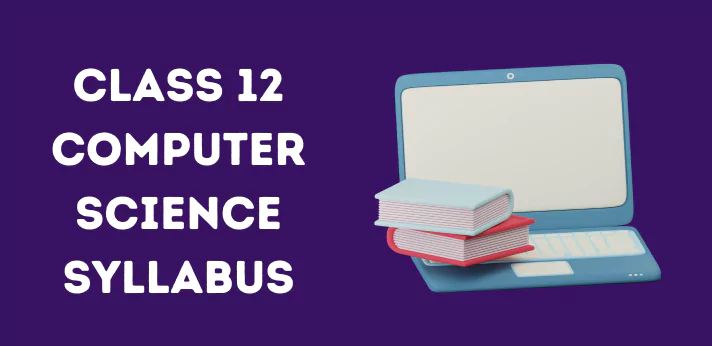The CBSE Class 12 Computer Science syllabus for the academic session 2025-26 has been updated. Students are encouraged to review the revised syllabus recently uploaded to the website.
[Index]
Overview
Before delving into the details of the Class 12 Syllabus, let’s take a look at the CBSE Class 12 Summary provided below. It encapsulates the entirety of the CBSE Class 12 curriculum. Students are encouraged to review the complete summary thoroughly.
| Particulars | Description |
| Class | 12th |
| Subject | Computer Science |
| Board | CBSE |
| Category | Syllabus |
| Study Materials | Class 12 Study Materials |
| E-Book | Class 12 E-Book |
| YouTube Channel | Subscribe now |
Class 12 Computer Science Exam Pattern 2025-26
In this section, we have mentioned the Class 12 Computer Science Exam Pattern. Students can check the Class 12 Computer Science Exam Pattern for the academic year 2025-26.
| Unit No. | Unit Name | Marks |
| 1. | Computational Thinking and Programming – 2 | 40 |
| 2. | Computer Networks | 10 |
| 3. | Database Management | 20 |
| Total | 70 |
Class 12 Computer Science Syllabus 2025-26 in PDF
In this section, we have mentioned the Computer Science Syllabus in PDF format with an exam pattern. Students can check the syllabus in PDF for the academic year 2025-26.
Class 12 Computer Science Syllabus Brief Review
Below, we have mentioned the CBSE Class 12 Computer Science Syllabus Brief Review, such as which topics/chapters will be covered in the syllabus. Students are advised to check the brief review of the Computer Science syllabus.
| Unit 1: Programming and Computational Thinking (PCT-2) | Unit 2: Computer Networks |
| Revision of Python Functions Exception Handling Introduction to files, types of files Text file Binary file CSV file Data-structures | Evolution of networking Data communication terminologies Transmission media Network devices Network topologies and Network types Network protocol Introduction to web services |
| Unit 3: Data Management | |
| Database concepts Relational data model Structured Query Language Interface of python with an SQL database |
Practical
Below, we have mentioned the Class 12 Computer Science Practical Syllabus, such as which topics will be covered in the practical. Students are advised to check the brief review of Computer Science syllabus Practicals.
Here’s the information from the image rewritten in a clean table format:
| S. No. | Unit Name | Marks (Total = 30) |
| 1 | Lab Test: 1. Python program (60% logic + 20% documentation + 20% code quality) 2. SQL queries (4 queries based on one or two tables) | 8 + 4 = 12 |
| 2 | Report File: • Minimum 15 Python programs • SQL Queries – Minimum 5 sets using one/two tables • Minimum 4 programs based on Python–SQL connectivity | 7 |
| 3 | Project (using concepts learnt in Classes 11 and 12) | 8 |
| 4 | Viva Voce | 3 |
NOTE:- If there is any change, the Syllabus will be updated soon.
Class 12 Computer Science Useful Resources
We have tried to bring CBSE Class 12 Computer Science NCERT Study Materials like Syllabus, Worksheet, Sample Paper, NCERT Solutions, Important Books, Holiday Homework, Previous Year Question Papers, etc. You can visit all these important topics by clicking the links given.
| S.No. | Computer Science Syllabus |
| 1 | Computer Science NCERT Solution |
| 2 | Computer Science Marking Scheme |
| 3 | Computer Science Sample Paper |
| 4 | Computer Science Previous Year Paper |

